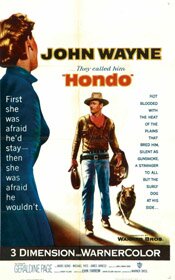 Directed by John Farrow
Directed by John Farrow
You don’t get more John Wayne than 1953’s Hondo. It’s a great Wayne western and that is surprising because it had two things going against it.
First is the fact that Wayne had his onscreen persona nailed by this time and the story almost seems to have been written with him in mind. The risk the movie had to play around was to avoid becoming parody by turning character into caricature.
The second is the period the movie was made. At this time, Hollywood was crazy for 3-D and so the movie was made that way.
Unfortunately, by the time the film came out 3-D’s day in the sun was past and interest was on the wane (no pun intended).
John Wayne as Hondo Lane.
More to the point for us now is that there is an emphasis on foreground, and some specific scenes in the film that are designed to garner ooh’s and ah’s from a 1953 audience watching 3-D.
Today, especially watching it in standard two dimensional style, they feel awkward and anachronistic. Even silly.
Yet the movie manages to avoid turning Wayne into a caricature and doesn’t really suffer from its period 3-D fascination.
In fact, as I’ve seen stated elsewhere, this is probably the best John Wayne western that wasn’t directed by either John Ford or Howard Hawks. (I think Don Siegel’s The Shootist could be a contender, however.)
IMDb summarizes things succinctly: “Army despatch rider Hondo Lane discovers a woman and her son living in the midst of warring Apaches, and he becomes their protector.”
Hondo (John Wayne) approaching the farmhouse and Angie Lowe (Geraldine Page) and her son.
John Wayne plays Hondo Lane; Geraldine Page plays Angie Lowe, the woman with a son Lane comes across.
What evolves from that meeting is essentially a romance though in a western setting and with all the trappings of a western, including Apaches at war.
The movie works because it is rooted in a Louis L’Amour story that James Edward Grant turned into an almost perfect western screenplay — certainly perfect for John Wayne when it came to his character and the dialogue.
It’s aided by an Oscar-nominated performance by Geraldine Page and an equally good, though strangely so due to the odd casting, performance of Michael Pate as Vittorio, the Apache chief.
What we end up with is a movie that has the requisite western drama and action but also rich characters that reveal themselves unhurriedly. It is in Hondo’s nature to be a man of few words though, when he does speak, what he says is rich with meaning and is one with his actions.
Hondo Lane and Angie Lowe (John Wayne and Geraldine Page).
Angie, the abandoned wife with a child, is also vague — even deceitful in what she says — because she’s unsure of who this man is and she is alone, in Apache territory, with a son to protect.
The two discover one another slowly and are attracted in part for the respect they have for one another.
The end result is almost a template for a good western — strong story, strong characters, and a story arc that when it is completed feels that way: complete.
This is just one really good western and is definitely worth seeing at least once.
(I’ve seen Hondo spoken of as being similar to another 1953 movie, Shane. But I think the similarity is superficial at best. They are alike in that there is a farmhouse and a stranger who comes upon it. The stranger is good with a good gun; the farmers are peaceful and domestic. Where the movies go from there is very different and there is little if any similarity in what the movies’ concern themselves with.)



Pingback: The romantic John Wayne | Piddleville